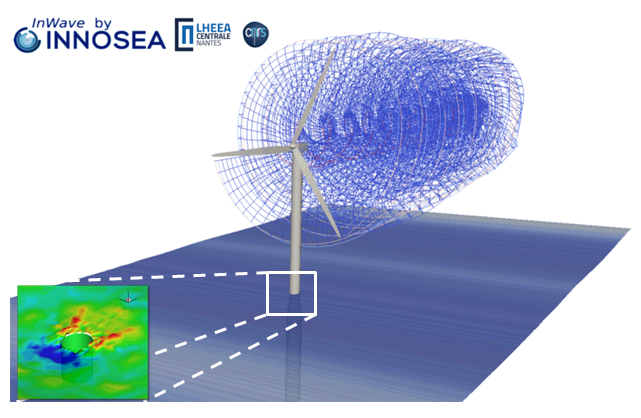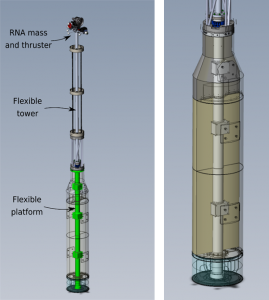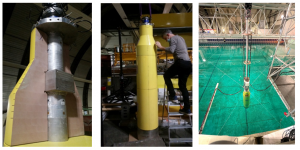
Background
Over the past decade, many simulators dedicated to the behaviour of floating wind turbines have been developed. The vast majority of these models are based on a multi-body formulation where the floating wind turbine is represented as a set of deformable and rigid bodies interconnected. The blades, the tower, the rotor shaft and the anchor lines are generally considered deformable while the platform and the floating support are assumed to be rigid.
While this approach may be sufficient for medium power rotors, the recent development of 10 to 15 MW rotors will require larger foundations for which the hydro-elastic effects should become significant.
Scientific advances and innovation
To cope with this new design challenge, LHEEA plans to expand the capabilities of its current floating turbine simulator. This project aims to develop a hydro-elastic solver for the calculation of structural loadings sustained by floating wind foundations. This work will involve the coupling of an “in-house” hydrodynamic solver based on a unsteady potential theory with a structural solver based on a finite element formulation. A second task will focus on the experimental validation that will be conducted at Centrale Nantes with a segmented model of a SPAR-type floating foundation .
Expected technical and economic impact
The scientific and technical impact of the project is on both the numerical and the experimental aspects of the project:
- The numerical modelling of the hydroelastic behavior of floating wind turbine foundations by means of a unstationary potential model would be a first of its kind in the floating wind energy community.
- Experimental results of floating wind turbine foundations with segmented models are very few; the proposed experimental campaign will be then strongly valuable for the community.
Key project milestones
- 05/04/2019 - Kick-Off
- 2019 - Numerical developments
- 2020 - Experimental tests
- March 2021 - End of the project
Results
- Numerical coupling between WS_CN hydrodynamic model with Beampy, two in-house hydrodynamic and structural models
- Design and manufacturing of 1:40th scale flexible model of spar platform designed to withstand a 10MW HAWT.
- Conduction of a wave tank tests campaign with the flexible spar-type platform under regular and irregular waves
- Creation of an experimental database dedicated to the validation of numerical solvers.


Publications and papers published
Oral communications
- Applied research activities dedicated to FOWT, Jean-Christophe Gilloteaux, FAID, Boston – 18-19 mars 2019
- Nonlinear hydroelastic responses of monopile and spar wind turbines in regular waves. Vincent Leroy, Jean-Christophe Gilloteaux, Erin E. Bachynski, Aurélien Babarit, Pierre Ferrant. EERA DeepWind’2020, 17th Deep Sea Offshore Wind R&D Conference, Trondheim, Norway, 15 – 17 January 2020
- A new approach for the prediction of the non-linear hydro-elastic behaviour of large floating wind turbines, Vincent Leroy, Jean-Christophe Gilloteaux, Erin E. Bachynski, Aurélien Babarit, Pierre Ferrant. FOWT 2020, 7/08 septembre 2020, Marseille, France
- Experimental investigation on the hydroelastic response of a spar-supported Floating Offshore Wind Turbine, V. Leroy, S. Delacroix, A. Merrien, E. E. Bachynski, J.-C. Gilloteaux, Wind Energy Science Conference, 25 – 28 May 2021 Hannover, Germany
Publications:
- onlinear hydroelastic responses of monopile and spar wind turbines in regular waves. Vincent Leroy, Jean-Christophe Gilloteaux, Erin E. Bachynski, Aurélien Babarit, Pierre Ferrant. EERA DeepWind’2020, 17th Deep Sea Offshore Wind R&D Conference, Trondheim, Norway, 15 – 17 January 2020
- A weak-scatterer potential flow theory-based model for the hydroelastic analysis of offshore wind turbine substructures, V.Leroy, E.E.Bachynski-Polić, A.Babarit, P.Ferrant, J.-C.Gilloteaux, Ocean Engineering, October 2021.






